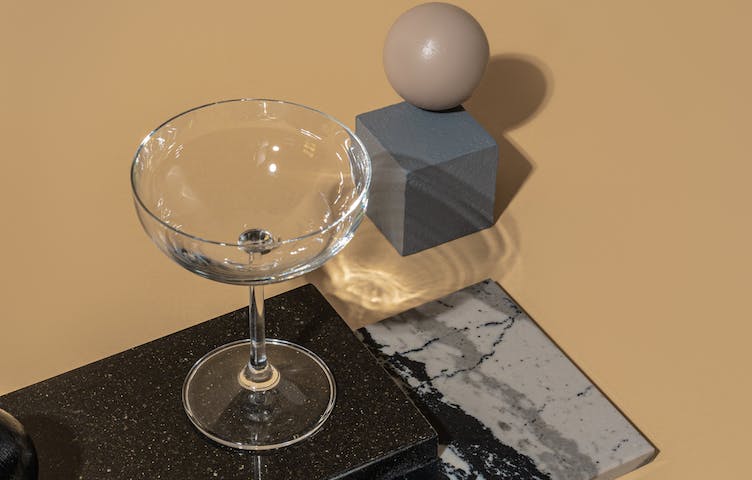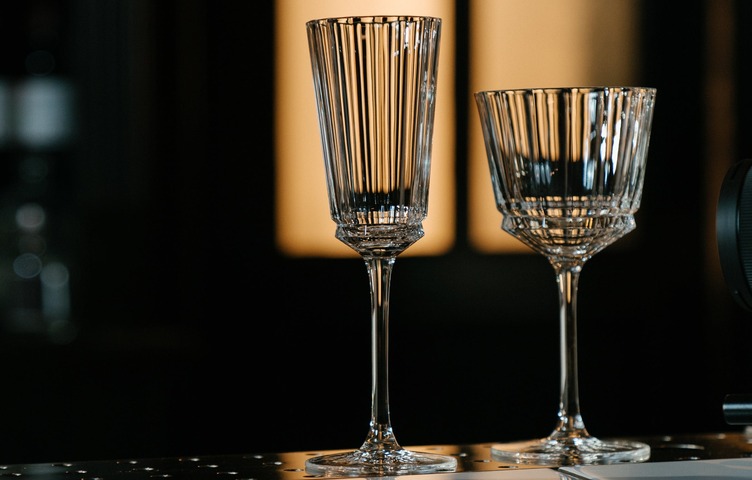A hundred years ago, sparkling wines were a privilege for the rich. Nowadays champagne is available to everyone, but we still associate it with celebration, romance, and success. The fizzy drink is usually served in special glasses that highlight its beauty, taste and aroma. Let's find out which glassware is best for serving holiday wine!
Types of glasses
The main feature of champagne is carbon dioxide bubbles, which create unusual visual and taste effects. This is a starting point for thinking about choosing a wine glass. The first pleasure from eating and drinking comes from the sense of smell. Gas bubbles carry volatile molecules of aromatic substances, revealing the bouquet of the wine.
They play an equally important role in the taste aspect. The more effervescence, the stronger the freshness. A correctly chosen glass helps the bubbles to escape and, therefore, emphasizes the taste and aroma of the drink.
By shape
There are two reasons why champagne tastes better in a special glass. First, a properly shaped vessel maintains the wine's effervescence , so the sparkling taste remains in the mouth. The neck directs aromatic substances directly to the nose, allowing you to enjoy the bouquet.
The second reason is psychological . The element of delight that arises when serving champagne in an elegant glass enhances the perception of taste.
There are three types of vessels for sparkling wines:
- ice cream bowl;
- flut;
- tulip.
Each of them has its fans and opponents, advantages and disadvantages.
Kremanka (“saucer”, chalet, bowl, fleur)

Scenes of luxury vacations in Hollywood films always show champagne in vessels similar to dessert bowls. This is the legendary “chalet” - a wine glass with a wide flat bowl and a high stem. Legend claims that this exquisite item was created for the French queen Marie Antoinette based on the shape of her breasts. The product was intended for drinking milk. Later, the elegant bowl turned into a wine glass. In the 18th and 19th centuries, champagne was made sweeter than it is now, and the fizzing of the bubbles was considered vulgar. The wide bowl, which quickly removed carbon dioxide, was an ideal vessel for sparkling wines.
Nowadays the chalet is considered an “old school” model. It is associated with the life of the aristocracy of past centuries and gives a special atmosphere to the holiday.
But the wide bowl disperses the gas bubbles too quickly, and this makes it difficult to savor the drink. It is not easy to drink from such a product, especially while standing during outdoor buffets. Serving champagne in bowls has become an elegant ritual.
Nowadays chalets are used mainly for alcoholic cocktails, including:
- strawberry daiquiri;
- bartender's choice;
- arno;
- blood and Sand;
- New Yorker.
Sparkling wines are served in ice cream glasses only in themed restaurants and vintage hotels.
Flute ("flute")

Since the thirties of the twentieth century , flute has become the standard for tasting champagne. This is a narrow glass with a cylindrical bowl and a thin stem. The elongated shape allows you to retain carbon dioxide in the drink longer. Thanks to this, the aroma does not disappear as quickly as in a bowl. The glass is comfortable to hold in your hand, even if you have to drink while standing. The long stem prevents the contents from heating up from the heat of the palm.
There are three varieties of flute :
classic - characterized by a cylindrical bowl with a narrow bottom. Served in most restaurants, during wine tastings, weddings and buffets;
the new one has a bowl with a slightly widened base. This design allows you to control the spread of gas bubbles and preserve the aroma;
zalto - named after the famous Austrian brand, which proposed an unusual modification of champagne glassware. It is a tall vessel with a conical bottom, an expansion in the middle of the bowl and a narrow neck. Recently introduced to the market, the zalto glass has become a standard in the world of winemaking.
Fine restaurants usually serve handmade lead crystal “flutes.” But such products are very expensive, so for the home they often buy crystal and glassware made by mechanical means.
Tulip or trampoline
lpan or trampoite" />
This model combines the characteristics of a chalet and flute. The shape of the bowl follows the contours of the flower of the same name, convex at the bottom and tapering at the top. Many wine experts use the “tulip” at tastings, claiming that it collects the aroma of the drink better than other glasses.
By material
Traditionally, sparkling wine glasses are made from crystal and glass . Transparent materials allow you to evaluate the shade of the product and highlight the spectacular play of gas bubbles.
The choice of crystal utensils is explained primarily by aesthetic perception. Sparkling crystal demonstrates the beauty of the drink and enhances the feeling of celebration. An additional note of joy is added by the ringing sound produced by crystal glasses when clinking glasses. Crystal itself, especially lead crystal, improves the taste of the drink. Its texture accelerates the movement of bubbles, so that the taste qualities are maximized.
Two types of crystal are used to produce wine glasses:
lead – contains 15-24% lead. It is characterized by high transparency and the ability to beautifully refract light;
lead-free – created without the use of lead. Instead, the composition includes zinc, potassium or barium. Its properties are not inferior to classic crystal, but it is officially called “crystal glass”.
Wine glasses made of ordinary glass look no less beautiful than crystal, but cost 2-3 times less. Glassware is inferior to crystal in strength; it heats up faster in air.
Rarer materials for making glasses are rock crystal and Murano colored glass. Champagne in such vessels looks very impressive. But due to the high price, exclusive wine glasses are found only in elite restaurants and private residences.
Recommendations for selection
True wine connoisseurs prefer to have two or three types of glassware at home for different types of drink. Exquisite champagne with a complex bouquet is served in bowls. For cheaper varieties, flute is suitable, which successfully hides defects in the product and makes its taste brighter. If sparkling wine appears in your home only on holidays, it is more profitable to buy a set of universal wine glasses. They are suitable for any light alcohol, including cocktails.

When choosing, pay attention to four more factors:
- material – lead crystal is considered a classic option. A worthy alternative would be crystal or Bohemian glass;
- wall thickness - the lower this indicator, the better the taste of the drink. A thickness of 3 mm is considered ideal; most cookware manufacturers adhere to this standard;
- care requirements - please note that crystal wine glasses will have to be washed only by hand, without soap. Narrow flutes cause the greatest difficulty in washing;
- style – stores offer a variety of designs, from minimalist glasses with smooth sides to vintage vessels with carvings and gilding. Please note that the more intricately designed the product, the more difficult it is to care for it.
There is no need to skimp on glasses - a good champagne set will remain in the house for several decades. Look for sets of six items, with a cost of at least 4,000 rubles.
How to care for glasses
Proper care is the main condition for the durability and preservation of the beauty of wine glasses. They must be washed immediately after use so that wine residues do not form sticky spots on the walls. Crystal and thin glassware should not be placed in the dishwasher. High temperatures and powerful water pressure can damage fragile items or make them cloudy.
- Wash glassware by hand with cool water and a mild detergent. Finally, rinse the glasses thoroughly and dry them with a lint-free cloth or paper towel. This will prevent cloudy spots from appearing.
- Crystal is washed without soap; heavy stains are removed with baking soda. To ensure that your dishes retain their characteristic shine, rinse them regularly with water acidified with lemon juice or white vinegar. After washing, wipe the items with a soft cloth and leave them on the table to dry completely.
- Champagne glasses are stored upright in a dry place. It is most convenient to use special containers for glassware. They will protect utensils from dust and possible damage.
The best manufacturers
When choosing glasses for your home, bar or restaurant, look for products from reputable brands, such as:
Pasabahce is a famous Turkish manufacturerdishes. Produces champagne glasses made of glass and lead-free crystal. The assortment includes various models of glasses - chalet, flute, tulip;
Arcoroc is a French brand that supplies drinkware to 160 countries. Offers glass flute and chalet glasses with volumes from 100 to 250 ml;
Chef&Sommelier is a manufacturer from France that creates equipment for the restaurant and hotel business. Offers a variety of crystal glass flute goblet options;
Rona is a company from Slovakia with a 130-year history. Produces hand and machine made crystal glass products. Creates flute glasses and champagne saucers in classic and retro styles;
Eclat is a popular French cookware brand. Produces premium glassware. Made from lead-free crystal, Eclat products are durable and elegant in design.
















































/https%3A%2F%2Fcomplexbar.com%2Fimages%2Fblog%2F245%2Fbokali-shampanskogo.jpg)
/https%3A%2F%2Fcomplexbar.com%2Fimages%2Fblog%2F245%2Fskov_glavn.jpeg)
/https%3A%2F%2Fcomplexbar.com%2Fimages%2Fblog%2F245%2Fhaiboli.jpg)
/https%3A%2F%2Fcomplexbar.com%2Fimages%2Fblog%2F245%2Fvilki-na-stole-752x480.jpeg)
/https%3A%2F%2Fcomplexbar.com%2Fimages%2Fblog%2F246%2F2024-04-09_17.22.54.jpg)
/https%3A%2F%2Fcomplexbar.com%2Fimages%2Fblog%2F246%2F2024-04-09_17.22.47.jpg)
/https%3A%2F%2Fcomplexbar.com%2Fimages%2Fblog%2F246%2FCODE_anons_foamydrops_752%D1%85480_eng.jpg)
/https%3A%2F%2Fcomplexbar.com%2Fimages%2Fblog%2F246%2FAlina_752%D1%85480_eng.jpg)
/https%3A%2F%2Fcomplexbar.com%2Fimages%2Fblog%2F246%2F2024-04-09_17.23.22.jpg)
/https%3A%2F%2Fcomplexbar.com%2Fimages%2Fblog%2F246%2F2024-04-09_17.23.28.jpg)
/https%3A%2F%2Fcomplexbar.com%2Fimages%2Fblog%2F246%2F2024-04-09_17.23.35.jpg)
/https%3A%2F%2Fcomplexbar.com%2Fimages%2Fblog%2F246%2Fdrinksome_752%D1%85480_eng.jpg)
/https%3A%2F%2Fcomplexbar.com%2Fimages%2Fblog%2F246%2Fnude_752%D1%85480_eng.jpg)
/https%3A%2F%2Fcomplexbar.com%2Fimages%2Fblog%2F246%2F752%D1%85480_eng__1_.jpg)
/https%3A%2F%2Fcomplexbar.com%2Fimages%2Fblog%2F246%2F752%D1%85480_eng.jpg)
/https%3A%2F%2Fcomplexbar.com%2Fimages%2Fblog%2F246%2FStudioRaw_752%D1%85480_eng.jpg)
/https%3A%2F%2Fcomplexbar.com%2Fimages%2Fblog%2F246%2FDoppio_tea_752%D1%85480_eng.jpg)
/https%3A%2F%2Fcomplexbar.com%2Fimages%2Fblog%2F246%2FTognana_Stars_Stripes_752%D1%85480_eng.jpg)
/https%3A%2F%2Fcomplexbar.com%2Fimages%2Fblog%2F246%2FRona_752%D1%85480_eng.jpg)
/https%3A%2F%2Fcomplexbar.com%2Fimages%2Fblog%2F246%2FDoppio_vending_752%D1%85480_eng.jpg)
/https%3A%2F%2Fcomplexbar.com%2Fimages%2Fblog%2F246%2FEssence_sukhie_smesi_752%D1%85480_eng.jpg)
/https%3A%2F%2Fcomplexbar.com%2Fimages%2Fblog%2F246%2FODK_sukhie_smesi752%D1%85480_eng.jpg)
/https%3A%2F%2Fcomplexbar.com%2Fimages%2Fblog%2F246%2Funiforma-barmena.jpg)
/https%3A%2F%2Fcomplexbar.com%2Fimages%2Fblog%2F246%2Fkak-nanyat-barmena.jpg)
/https%3A%2F%2Fcomplexbar.com%2Fimages%2Fblog%2F246%2Fsirop_scale_2400.jpeg)
/https%3A%2F%2Fcomplexbar.com%2Fimages%2Fblog%2F246%2FPeugeot_Anons_Paris_U%27Select_Line_Daman_752%D1%85480_eng.jpg)
/https%3A%2F%2Fcomplexbar.com%2Fimages%2Fblog%2F246%2Fkofe-vostochniy.jpg)
/https%3A%2F%2Fcomplexbar.com%2Fimages%2Fblog%2F246%2FMadler.jpg)
/https%3A%2F%2Fcomplexbar.com%2Fimages%2Fblog%2F246%2Fprofbartender_glavn.jpeg)